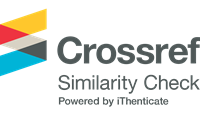Mecanismos de formação de cultura empática de alunos de universidades pedagógica e médica
Resumo
A relevância deste estudo se deve ao insuficiente desenvolvimento metodológico dos mecanismos e métodos para a formação da empatia entre estudantes de faculdades pedagógicas e médicas, importante competência profissional de futuros professores e médicos. A cultura empática de professores e médicos é parte integrante da cultura pessoal, um componente da habilidade profissional que requer formação e desenvolvimento propositais. O objetivo do estudo é fundamentar teoricamente e testar experimentalmente os mecanismos de formação da cultura empática em alunos de universidades pedagógicas e médicas. O principal método de pesquisa baseia-se nos diagnósticos selecionados: 1. O método de diagnóstico do controle comunicativo (M. Schneider); 2. Programa de avaliação de comunicação não verbal (A.M. Kuznetsova); 3. Metodologia ‘Balanced Emotional Empathy Scale’ (A. Mehrabian, E. Epstein). Resultados. Na profissão de médico e professor, temos demonstrado que a empatia é uma importante qualidade profissional. A maioria dos alunos das universidades pedagógicas e médicas apresentou níveis médios de cultura empática. Os canais emocionais e de atividade da empatia são mais desenvolvidos entre os professores, e os canais cognitivos são mais desenvolvidos entre os médicos. Significado prático. Os resultados do estudo podem ser utilizados na formação profissional de alunos de universidades pedagógicas e médicas.
Downloads
Referências
Chen, X., Zhang, Y., Xu, X., Wang, W., Yan, H., Li, S., & Yang, N. (2019). Mediating roles of anxiety, self-efficacy, and sleep quality on the relationship between patient-reported physician empathy and inflammatory markers in ulcerative colitis patients. Medical Science Monitor, 25, 7889-7897. DOI: https://doi.org/10.12659/MSM.917552
Dolgova, V. I., & Melnik, E. V. (2014). Empathy. Moscow, RU: Pero Publishing House.
Fetiskin, N. P., Kozlov, V. V., & Manuilov, G. M. (2002). Methods of expert assessment of non-verbal communication. In Social and psychological diagnostics of personality development and small groups (p. 120-121). Moscow, RU: Institute of Psychotherapy
Friedemann, M. H.-H. O. (2013). Kriterien-basierte Beurteilung der Anamnesequalität und Empathiefähigkeit von PJ-Studierenden in Hamburg (Dissertação de Mestrado). Universität Hamburg, Hamburg.
Garnett, S., Dambha-Miller, H., & Stuart, B. (2020). Quantifying empathy levels among UK undergraduate medical students: an online survey. British Journal of General Practice, 70 (Suppl. 1), bjgp20X711293. DOI: https://doi.org/10.3399/bjgp20X711293
Geffrey, D. (2017). Communicating with a human voice: developing a relational model of empathy. Journal of the Royal College of Physicians of Edinburgh, 47(3), 266-270. DOI: https://doi.org/10.4997/JRCPE.2017.312
Haque, M. (2020). Empathy among medical students is an essential requirement to be a respectable and holistic medical doctor. Bangladesh Journal of Medical Science, 19(3), 355-357. DOI: https://doi.org/10.3329/bjms.v19i3.45849
Ilyin, E. P. (2013). Emotions and feelings (2nd ed.). St. Petersburg: Peter.
Jung, С. (1996). Psychological types. Moscow, RU: University book.
Kanchan, T., & Krishan, K., & Dehal, N. (2018). Quality of medical education: is our health in safe hands? Indian Journal Medical Ethics, III(3), 259. DOI: https://doi.org/10.20529/IJME.2018.021
Kohut, H. (2000). Introspection, empathy, and psychoanalysis: a study of the relationship between mode of observation and theory: an anthology of contemporary psychoanalysis. Moscow, RU: Institute of Psychology of the Russian Academy of Sciences.
Krishnasamy, C., Ong, S. Y., Loo, M. E., & Thistlethwaite, J. (2019). How does medical education affect empathy and compassion in medical students? A meta-ethnography: BEME Guide no. 57. Medical Teacher, 41(11), 1220-1231. DOI: https://doi.org/10.1080/0142159X.2019.1630731
Kuznetsova A. M. (2002). Methodology of expert evaluation of nonverbal communication / Social and psychological diagnostics of development of personality and small groups. - М., 2002. C.242-244.
Lermen, C., Wetzel, W., Britz, V., Sterz, J., Bechstein, W., & Schreckenbach, T. (2022). Empathy, personality traits, and emotional management in 2nd and 4th-year dentistry students: a single-center study. BMC Medical Education, 22(2). DOI: https://doi.org/10.1186/s12909-021-03080-1
Lipps, T. (1907). Guide to psychology. St. Petersburg, RU: O. N. Popov Publishing House.
Nemov, R. S. (1999). Fundamentals of psychological counseling: Proc. for stud. Of pedagogical universities. Moscow, RU: Publishing Center VLADOS.
Omid, A., Haghani, F., & Adibi, P. (2018). Emotional intelligence: an old issue and a new look in clinical teaching. Advanced Biomedical Research, 7(1), 32. DOI: https://doi.org/10.4103/2277-9175.225926
Podlasy, I. P. (2004). Pedagogy of elementary school: textbook for stud. pedagogical schools and colleges. Moscow, RU: Publishing Center VLADOS.
Professional standard of a teacher. (2013). Bulletin of Education, 8. 4-44.
Rogers, C. (1994). A look at psychotherapy. The formation of man: a monograph. Moscow, RU: Progress.
Rogers, C. R. (1975). Empathic: an unappreciated way of being. The Counseling Psychologist, 5(2), 2-10. DOI: https://doi.org/10.1177/001100007500500202
Shapiro, J., Morrison, E., & Boker, J. (2004). Teaching empathy to first year medical students: evaluation of an elective literature and medicine course. Education for Health (Abingdon), 17(1), 73-84. DOI: https://doi.org/10.1080/13576280310001656196
Shkitina, N. S., Elagina, V. S., & Nemudraya, E. Y. (2014). Future teachers empathy training. Modern Problems of Science and Education, 3.
Schneider, K. (1999). Clinical psychopathology (Transl. from German). Kiev: Sphere.
Simonova, Z. G. (2013). Medical humanities in the process of training of future doctors as a means of overcoming the problem of dehumanization of medicine in the XXI century. Modern Problems of Science and Education, 3.
Sinyagina, N. Y. & Derkach, A. A. (1998). Socio-perceptive characteristics of the teacher's personality. Development of social-perceptual 180 competence of the individual: materials of the scientific session dedicated to the 75th anniversary of A.A. Bodalev. Moscow, RU: Luch.
Sobczak, K., & Popowicz, B. (2019). The analysis of the empathy factor in students of medical sciences. Polish Annals of Medicine, 26(2), 145-150. DOI: https://doi.org/10.29089/2019.19.00079
Yu, C. C., Tan, L., Le, M. K., Tang, B., Liaw, S. Y., Tierney, T., … Low, J. A. (2022). The development of empathy in the healthcare setting: a qualitative approach. BMC Medical Education, 22, 245. DOI: https://doi.org/10.1186/s12909-022-03312-y
Zakharova, E. A., Ezhova, Y. M., & Rakov, N. A. (2019). Empathy as a basis for doctor-patient communication: current state of the problem. Psychology. Historical-critical Reviews and Current Researches, 8(3A), 119-138.
Zhou, Y. C., Tan, S. R., Tan, C. G. H., Ng, M. S. P., Lim, K. H., Tan, L. H. E., … Krishna, L. K. R. (2021). A systematic scoping review of approaches to teaching and assessing empathy in medicine. BMC Medical Education, 21, 292. DOI: https://doi.org/10.1186/s12909-021-02697-6
Zimina, N. A. (2015). Psychological diagnostics of personality's communicative potential: guidelines for students. Nizhny Novgorod, RU: Nizhny Novgorod State University of Architecture and Civil Engineering.
This work is licensed under a Creative Commons Attribution 4.0 International License.
DECLARAÇÃO DE ORIGINALIDADE E DIREITOS AUTORAIS
Declaro que o presente artigo é original, não tendo sido submetido à publicação em qualquer outro periódico nacional ou internacional, quer seja em parte ou em sua totalidade.
Os direitos autorais pertencem exclusivamente aos autores. Os direitos de licenciamento utilizados pelo periódico é a licença Creative Commons Attribution 4.0 (CC BY 4.0): são permitidos o compartilhamento (cópia e distribuição do material em qualquer suporte ou formato) e adaptação (remix, transformação e criação de material a partir do conteúdo assim licenciado para quaisquer fins, inclusive comerciais).
Recomenda-se a leitura desse link para maiores informações sobre o tema: fornecimento de créditos e referências de forma correta, entre outros detalhes cruciais para uso adequado do material licenciado.















































